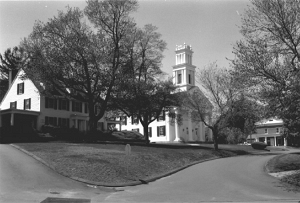Watertown Historic District
- District Overview
- Inventory List
- Town:
- Watertown »
- Year of Establishment:
- 1996
- Overlapping Historic Designation(s):
- LHD, NRHD, SR
- District Authority:
- Historic District Commission
- Link to Commission or Municipal Website:
- Map:
-
Map of the local historic district obtained from the Historic District Study Committee Report, 1996, SHPO, Hartford.
View photo - District Character:
- Town center
- Features:
The district comprises of The Green, parks and approximately 113 buildings including three churches, a schools and several buildings that currently house most of the offices of the town government.
- Architectural Style:
The area has excellent examples of Federal, Greek Revival, Italianate, Victorian Gothic, Queen Anne and Colonial Revival style buildings. [3]
- Era:
- 19th Century, 20th Century
- General description:
The Watertown Center Historic District encompasses the town's civic and residential center. It is located on a ridge above the commercial area of Main Street and the manufacturing section to the east along Steele Brook. The age and type of buildings in the district is a reflection of the changing economic basis of the town during the first two-thirds of the 19th century. Up to about 1840, the area was mostly occupied by small farms, two churches and a few fledgling merchant's enterprises. In the 1840s, when several of these farmers and small businessmen, such as Eli Cutis, George Woodruff, Alanson Warren, Nathaniel Wheeler, Merrit Heminway and Benjamin DeForest began to engage in manufacturing endeavor such as the production of Panama hats (Curtiss), sewing machines (Warren and Wheeler), buckles (Woodruff) and silk (Heminway), this area of Watertown became the location for their grand homes, including The Green, designed by Henry Austin. This period of prosperity, which extended through the turn of the century, was the era of the district's greatest growth, while relatively little building has occurred in the area since then. As a result of this building pattern, the area has excellent examples of Federal, Greek Revival, Italianate, Queen Anne ad Colonial Revival Style buildings. There is even a castellated Gothic Revival style dwelling, a rarity in the state. Italianate and Greek Revival houses do predominate however. As a complete assemblage of buildings, the district forms a cohesive image that has remained virtually unchanged. [2]
- Significance of the district:
Architecture, Social history (Criteria A & C):The Watertown Center Historic District is an exceptionally cohesive, well-preserved collection of residential and institutional architecture that illustrates the development of the community from settlement through the mid-twentieth century. An extraordinary number of professional architects contributed to the quality of design and the stylistic range of the district from about 1850 to 1920. Many notable examples of the Greek Revival and Italianate styles of the antebellum period were built for entrepreneurs associated with the founding of Watertown's major industries. The Queen Anne style was popular in the late 1800s, a progressive civic period also distinguished by the erection of handsome masonry buildings influenced by the Richardson an Romanesque style. More than half the houses were constructed or remodeled in the Colonial Revival renaissance that followed, a period that produced many significant residential buildings. The Watertown Center Historic District is distinguished by an exceptional array of impressive institutional buildings and stylish houses. Rarely does an entire district have such a concentration of contributing resources or display such an extraordinarily high level of quality and historic architectural integrity. Many well-known architects contributed to the district's significance. Among those who have been identified are David Hoadley, arguably the most important Connecticut architect/builder of the Federal period, to Henry Austin of New Haven, considered to be the master of the Italianate Villa style. Cameron Clark and Cass Gilbert, two of the most important architects of the early twentieth century, are both represented. Although technically not an architect, master builder Steven Baldwin of New Hartford deserves to be included with these professionals. Some, like Waterbury architects Wilfred Griggs and Robert Wakeman Hill, practiced in the region; others came from out of state, such as Alien & Collens of Boston, a firm that specialized in ecclesiastical architecture.
- District Boundary (according to the LHD Study Report, copied in 2010):
The district includes The Green and properties along the following main roads: Academy Hill, DeForest Street, Dickerman Street, Hamilton Avenue, Main Street, North Street, Warren Way, Woodbury Road and Woodruff Avenue, as described in the district ordinance.
- Sources:
[1] District information retrieved from the town website http://www.watertownct.org/.[2] Watertown Historic District, Report of the Historic District Study Committee, 1996, SHPO Library, Hartford. [3] Watertown Historic District Regulations and Rules of procedure, Watertown Historic District Commission, SHPO Library, Hartford. [4] Assessors information and Parcel IDs retrieved from the website www.visionappraisal.com and http://www.watertownct.org/content/10298/4286/11055/default.aspx.[NR] Cunningham Jan, Watertown Center Historic District, National Register Nomination Number- 01000352 NRIS, National Park Service, 2001 - http://pdfhost.focus.nps.gov/docs/NRHP/Text/01000352.pdf; http://pdfhost.focus.nps.gov/docs/NRHP/Photos/01000352.pdf
- Notes:
The local historic district and the National Register historic district do not share the same boundary.
- Disclaimer:
Content for this website and district boundaries were compiled from several sources and are subject to change. Boundaries for LHDs may be different from those of State or National Register Districts. To verify the boundaries and particulars of a specific district, consult the LHD study report on file with the respective municipal authority or the State Historic Preservation Office.
- Date of Compilation:
- 10/15/11
- Compiler:
- Manjusha Patnaik, CT Trust for Historic Preservation
